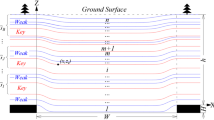Abstract
Longwall coal mining causes a large scale of subsidence in both overlying strata and ground surface. No matter where subsidence or deformation happened, its damaging effects to underground mining work or surface infrastructures are not anticipated. To accurately predict surface subsidence over the mining area, surface subsidence prediction models based on influence function method are developed. Based on the surface subsidence model, in this paper, a prediction model for overlying strata movements is developed with innovatively optimizing three key parameters used for setting the boundary condition. A load is derived using the beam theory with the simple overlying strata model, which is important for getting the radius of major influence, one of the three key parameters. Many features of progress subsidence are reproduced in the model and finally found to fit reasonably well with numerical simulation results using the same geological parameters. The modelling study reveals that the newly proposed subsurface model is flexible and versatile to represent the subsurface subsidence profile under various possible conditions. The key strata, especially the hard rock strata, act like an elastic beam and can overhang the load from above strata so that the displacement of rock mass or stress distribution in strata will be drastically changed when close to key strata. The proposed subsurface subsidence prediction model discloses some basic laws of overlying strata subsidence with the mining of coal seam.

















Similar content being viewed by others
References
Akinkugbe OO (2004) A simple two-dimensional boundary element program for estimating multiple seam interaction. M.S., Morgantown, West Virginia University, p 174
Akinkugbe OO et al (2004) The new two-dimensional Lamodel program. In: 24th International conference on ground control in mining, West Virginia University, pp 146–153
Alejano LR, Ramirez-Oyanguren P et al (1999) FDM predictive methodology for subsidence due to flat and inclined coal seam mining. Int J Rock Mech Min Sci 36:475–491
Chen SG, Hu W (2009) A comprehensive study on subsidence control using COSFLOW. Geotech Geol Eng 27(3):305–314
Du X (2010) The impacts of longwall mining on groundwater systems. Ph.D. Morgantown, West Virginia University, p 310
Gurtunca G (1984) Studies of subsurface subsidence in the southern coalfield of New South Wales. Ph.D. New South Wales, University of New South Wales, p 331
Holla L, Armstrong M (1986) Measurement of subsurface strata movement by multiborehole instrumentation. Bull Proc Australas Inst Min Metall 291(3):65–72
Holla L, Hughson B (1987) Strata movement associated with longwall mining. In: Proceedings of 6th australian tunnelling conference. Parkville, pp 211–216
Knothe S (1957) Observation of surface movements under influence of mining and their theoretical interpretation. European congress on ground movement, Leeds, UK, pp 210–218
Kratzsch H (1983) Mining subsidence engineering. Springer, Berlin
Kwinta A (2012) Prediction of strain in a shaft caused by underground mining. Int J Rock Mech Min Sci 55(3):28–32
Lee JS, Seo JH et al (2013) Simulation study on effect of drain underlap in gate-all-around tunneling field-effect transistors. Curr Appl Phys 13(6):1143–1149
Liu TQ et al (1981) Surface movement overlying failure and its application. Coal Industry Publishing Co., Beijing, p 369 (in Chinese)
Luo Y, Peng S (2000) Prediction of subsurface subsidence for longwall mining operations. In: Proceedings of 19th international conference on ground control in mining, pp 163–170
Luo Y, Qiu B (2012) Enhanced subsurface subsidence prediction model that considers overburden stratification. Min Eng 64(10):78–84
Peng SS (1992) Surface subsidence engineering. Society for mining, metallurgy, and exploration, Littleton, CO
Shen B, Poulsen BA et al (2011) Overburden strata movement and stress change induced by longwall mining. In: 45th US rock mechanics/geomechanics symposium. San Francisco, pp 1–8
Shu D, Bhattacharyya A (1990) Relationship between subsurface and surface subsidence—a theoretical model. Min Sci Technol 11(3):307–319
Whittaker B, Gaskell P et al (1990) Subsurface ground strain and fracture development associated with longwall Mining. Min Sci Technol 10(1):71–80
Xie H, Zhou H et al (1999) Application of flac to predict ground surface displacement due to coal extraction and its comparative analysis. Chin J Rock Mech Eng 18(4):397–401
Acknowledgements
This work is financially supported by grants from the Open Fund from Key Laboratory of Safety and High-efficiency Coal Mining, Ministry of Education (Grant No. JYBSYS2015108) and China Postdoctoral Science Foundation funded project (Grant No. 2015MS581897). The authors are grateful for these supports.
Author information
Authors and Affiliations
Corresponding author
Rights and permissions
About this article
Cite this article
Cheng, J., Zhao, G. & Li, S. Predicting Underground Strata Movements Model with Considering Key Strata Effects. Geotech Geol Eng 36, 621–640 (2018). https://doi.org/10.1007/s10706-017-0307-8
Received:
Accepted:
Published:
Issue Date:
DOI: https://doi.org/10.1007/s10706-017-0307-8




